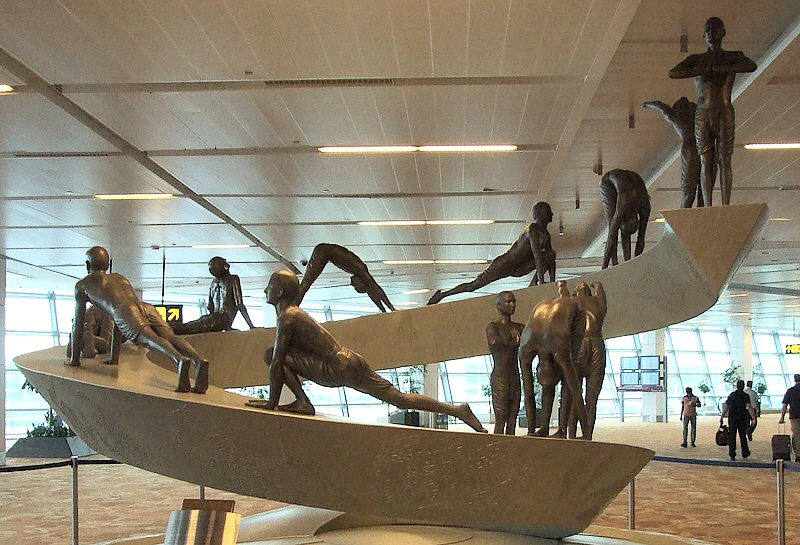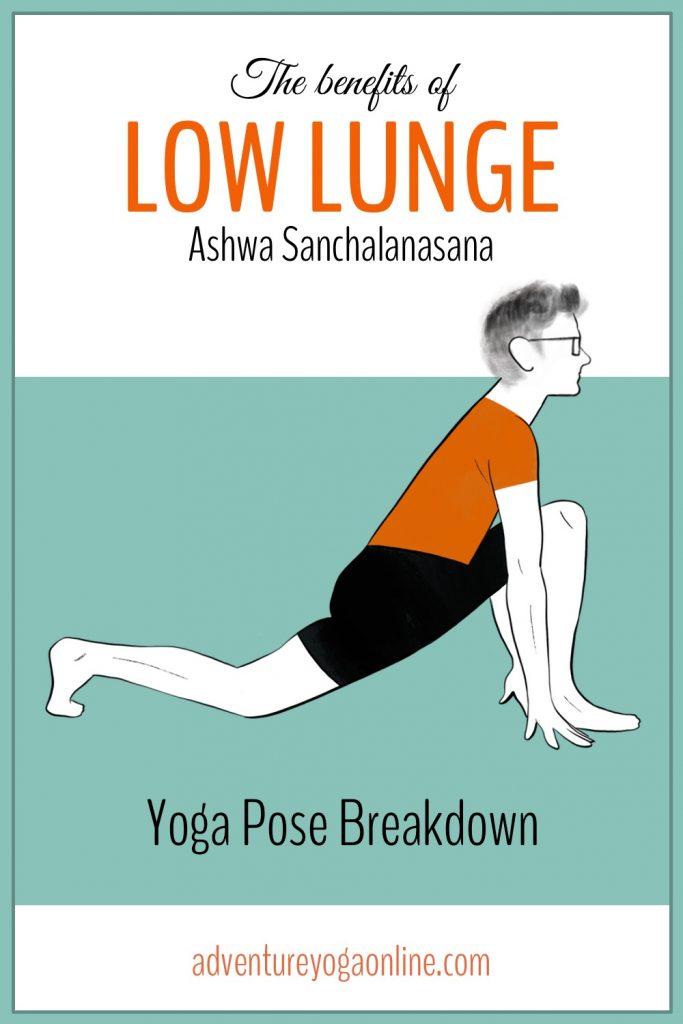Want to learn more about Ashwa Sanchalanasana, aka Low Lunge? In this post, I share the benefits of Ashwa Sanchalanasana, a complete pose breakdown, contraindications, myths, modifications and more.

Ashwa Sanchalanasana, more commonly known as Low Lunge, is part of the original Surya Namaskar sequence as taught by Krishnamacharya, The Father of Modern Yoga.
There is a beautiful series of statues in the Delhi airport depicting the sequence. As a yoga teacher, I felt it was really quite magical to see yoga being honoured in this way in a major hub airport in India.
This article may contain affiliate / compensated links. For full information, please see our disclaimer here.
Ashwa Sanchalanasana Quick Facts
| Sanskrit | Ashwa Sanchalanasana |
| English | Low Lunge / Horse Riding Pose / Equestrian Pose |
| Pronunciation | AH-sh-wah sahn-chal-AHS-uh-nuh |
| Meaning | Ashva (or ashwa) means horse. Sanchalana means stepping, riding or moving. Asana means seat or posture. The English translation is Horse Riding Pose, though I’m pretty sure I’ve never heard anyone call it this in yoga class. The name Ashwa Sanchalanasana is equally rare — usually yoga teachers who teach in English call this pose Low Lunge. |
Ashwa Sanchalanasana Benefits
Note: I only include the scientifically supported benefits of Low Lunge here. Plenty of claims about other supposed benefits (from the plausible to the magical to the ridiculous) have been made. To me, pseudo-scientific claims only serve to harm the yoga community, so I choose not to give them airtime here.
The main physical benefits of Ashwa Sanchalanasana include:
- Stretches the hips on the back leg.
- Opens the hip flexors and strengthens the hip extensors of the back leg.
- Stretches the psoas muscles on the side with the leg extended.
- Strengthens the quadriceps, gluteus maximus and hamstrings.
- Stretches the calf muscles on the front leg.
- Builds strength for the muscles that support the knee.
- Engages the deep core muscles, which helps create stability and improve balance.
- Can help alleviate pain caused by sciatica.
- Helps prepare the spine and the back muscles for back bends.
- Helps students learn to how to keep their hips square in a split leg pose to prepare for same work in Virabhadrasana 1.
- The spine lengthens while the hands are grounded which helps students learn they can use opposing forces to create stability.
Note: Because of the split legs in this pose a lot of what is stretched on one side of the pose strengthens when you switch sides, and vice versa.
A study on the different lunge variations showed that they are some of the best lower body strengthening exercises. The use of your body weight “produces more activation in the majority of all muscles analyzed [lower limb muscles] compared to squats.”
This makes sense since lunges put you in a less stable body position than a squat. The instability activates and strengthens underutilized muscles.
If you want more on the benefits of yoga, see our complete guide to the benefits of yoga, which includes a history of yoga plus the origins of our modern yoga practice and much more.
Precautions & Contraindications
Remember that while yoga is for everyone, not all poses are for all people! If your body requires some extra support in this pose, see the Modifications section below for ideas on how to do this pose safely.
- If you have an injury to your lower back, quadriceps, groin, knees or hips, practice this pose with awareness and if you feel pain, come out of the pose and rest.
- Practicing Ashwa Sanchalanasana improves the strength and flexibility of the hips and the knees, but also places pressure in these areas, which can lead to strain or injury.
- If you have a neck injury, or are prone to headaches, be sure to keep your neck long and gaze forward to help build strength in your neck’s supporting muscles.
- If you have a foot, toe, or Achilles tendon injury, balance can be difficult. There are some modifications recommended below to help with your balance.
- If you have a hip injury or recently had hip replacement surgery, this pose can put unwanted pressure on the hip joint.
Ashwa Sanchalanasana Pose Breakdown
How to do Ashwa Sanchalanasana / Low Lunge Pose
- Stand in Tadasana with your feet hip distance apart and parallel to each other.
- Fold forward into Uttanasana. Come up onto your fingertips.
- Step your right leg back. Keep your feet hip-distance apart even as you step back into the lunge shape. Have your left knee over your left ankle so that your shin is straight up and down. Have your right foot back far enough so that the heel of your right foot is over the ball of your right foot.
- Bend your right knee and as you bring it down to the ground also stretch your knee back slightly.
- Place your hands on the ground on either side of your front foot. I recommend being on your fingertips as this gives you more length in your arms, which allows you to lift your torso more. This also builds strength in your fingers.
- Look forward and lengthen your neck.
- This is Ashwa Sanchalanasana or Low Lunge Pose.
- Lift your right knee off the ground and step forward. Change sides.
- Balasana (Child’s Pose) or Adho Mukha Svanasana (Downward Dog Pose) make good counter poses.
NOTE: You can also enter this pose from Adho Mukha Svanasana. However, stepping forward from Downward Facing Dog can be more difficult for people than stepping back. Also, when entering the pose by stepping back, it is easier to ensure your front knee stays over your ankle.

Modifications and Variations
If you can’t balance
If you find it difficult to balance in Low Lunge, you can:
- Use a yoga chair in front of you and place your hands on the chair for support.
- Another good option is to place yoga blocks under your hands. This will help lift your torso and can also help with balance.
- Or, you can practice this at a wall with your back foot pressing into the wall. This can help you activate your posterior chain and your deep core so you create more strength and stability.
If your back knee hurts
If having your knee down on the ground hurts, place a yoga blanket under your knee to protect it, or fold the edge of your yoga mat over so that it is twice as thick.
If your ankle or Achilles tendon hurts
If you have Achilles tendon or ankle injury, you can use a yoga wedge under your front foot. Place the wedge on your mat with the thick edge towards your body. Place your foot on the wedge so that your heel is raised and your toes are pushing into the ground.
This will lessen the amount of dorsiflexion at your ankle and limit the stretch to your Achilles tendon.
Yoga Poses Related to Low Lunge Pose
Preparatory Poses
- Vajrasana / Thunderbolt Pose
- Adho Mukha Svanasana / Downward Facing Dog Pose
- Uttanasana / Forward Fold
- Utkatasana / Fierce Pose or Chair Pose
- Virasana / Hero Pose
- Supta Virasana / Reclined Hero Pose
- Ashta Chandrasana / Crescent Lunge
- Banarasana / High Lunge
- Trikonasana / Triangle Pose
- Virabhadrasana 2 / Warrior 2
Follow-up Poses
- Virabhadrasana 1 / Warrior 1
- Ashta Chandrasana / Crescent Lunge
- Garudasana / Eagle Pose
- Adho Mukha Svanasana / Downward Dog Pose
Poses To Take Your Practice Further
- Anjaneyasana / Son of Anjani Pose
- Parsvottansana / Pyramid Pose
- Eka Pada Rajakapotasana 2 / One Leg King Pigeon 2
- Virabhadrasana 3 / Warrior 3
Related Posts & Videos
- Post: High Lunge Benefits & Pose Breakdown
- Post: Virabhadrasana 1 Benefits & Pose Breakdown
- Video: Low Lunge Pose Breakdown
Gear & Resources for This Pose
- BKS Iyengar’s Light on Yoga
- Darren Rhodes Yoga Resource Practice Manual
- Yoloha Cork Yoga Mat with plant-based foam
- Yoloha Cork Yoga Blocks
- Machine Washable Vegan Yoga Blankets
- Foam Yoga Wedge
- Folding Yoga Chair
Save 10% on cork yoga gear
- Use our code AYO10 at checkout for 10% off all Yoloha yoga mats & gear.
Good for the planet and great for your practice!
A Final Note About Low Lunge Pose
While Ashwa Sanchalanasana might look like an easy pose, any pose that has this many points of contact with the ground is an invitation to take the pose inside and really work to activate all of the supporting muscles. This will help you build strength and focus, so you are prepared for moving into Anjaneyasana or Ashta Chandrasana.
See you on (and off) the ice OMies, Stephen ![]()
I hope this post has been helpful in expanding your possibilities with Low Lunge Pose. It’s my goal to inspire you to explore your yoga practice more deeply while enabling you to cultivate the strength and clarity needed to live your life adventure to the fullest!

